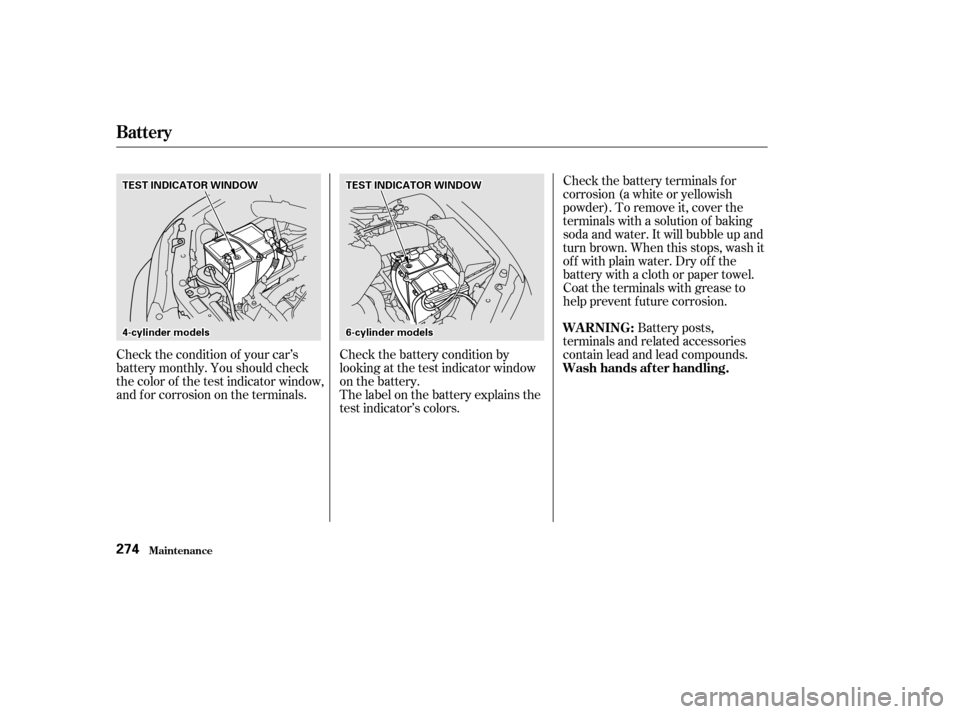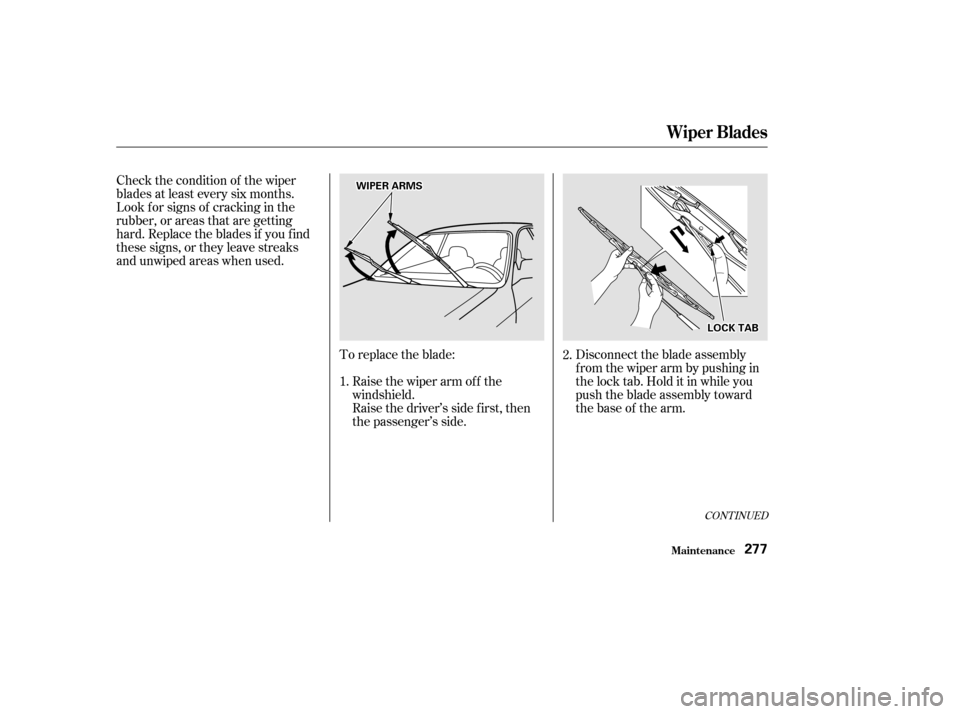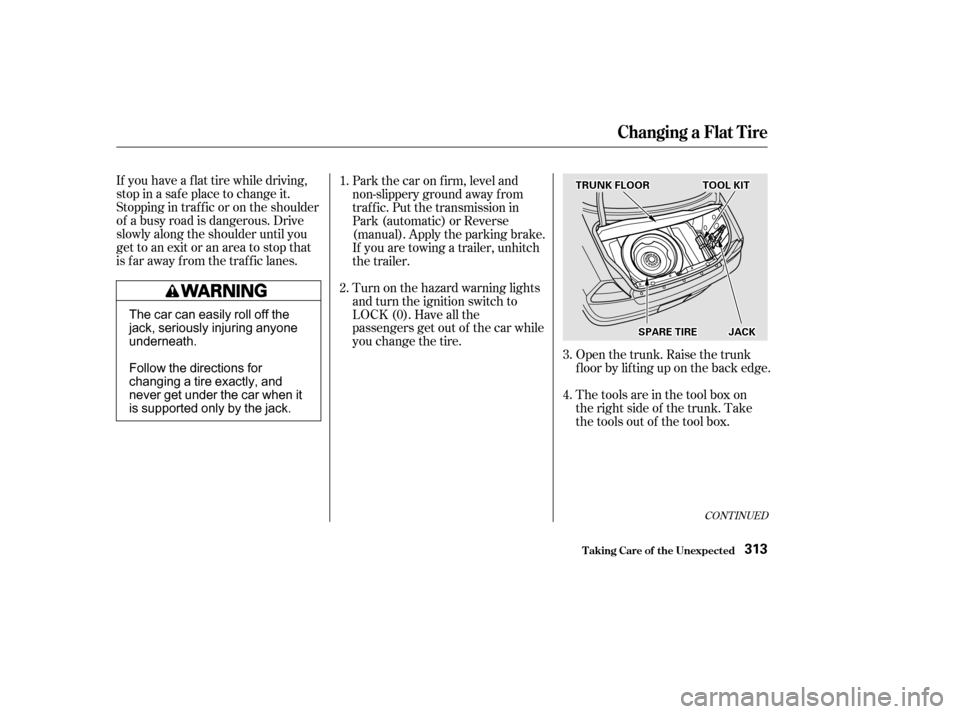tow HONDA ACCORD COUPE 2002 CL7 / 7.G Owner's Manual
[x] Cancel search | Manufacturer: HONDA, Model Year: 2002, Model line: ACCORD COUPE, Model: HONDA ACCORD COUPE 2002 CL7 / 7.GPages: 375, PDF Size: 4.89 MB
Page 277 of 375

Check the battery condition by
looking at the test indicator window
on the battery.
The label on the battery explains the
test indicator’s colors.
Check the condition of your car’s
battery monthly. You should check
the color of the test indicator window,
and f or corrosion on the terminals. Check the battery terminals for
corrosion (a white or yellowish
powder). To remove it, cover the
terminals with a solution of baking
soda and water. It will bubble up and
turn brown. When this stops, wash it
of f with plain water. Dry of f the
battery with a cloth or paper towel.
Coat the terminals with grease to
help prevent f uture corrosion.
Battery posts,
terminals and related accessories
contain lead and lead compounds.
Battery
Maint enance
WARNING:
Wash hands af ter handling.
274
T T E
ES
ST T I
INND DI
ICCA A T
TO
OR R W
WI INND DO
OW W
4
4- -c
cy yl liinn d
de
err m
m o
od
de
ellss T
T
E
ES
ST T I
INND DI
ICCA A T
TO
OR R W
WI INND DO
OW W
6
6- -c
cy yl liinn d
de
err m
m o
od
de
ellss
Page 280 of 375

Check the condition of the wiper
blades at least every six months.
Look f or signs of cracking in the
rubber, or areas that are getting
hard. Replace the blades if you f ind
these signs, or they leave streaks
and unwiped areas when used.Disconnect the blade assembly
fromthewiperarmbypushingin
the lock tab. Hold it in while you
push the blade assembly toward
thebaseof thearm.
Raise the wiper arm of f the
windshield.
To replace the blade:
Raise the driver’s side f irst, then
the passenger’s side. 2.
1.
CONT INUED
Wiper Blades
Maint enance277
L LO OC CKK T
TA
A B
B
W
WI
IPP E
ER
R A
AR
RMM S
S
Page 304 of 375

Block the rear wheels.
Fill the f uel tank.
Change the engine oil and f ilter
(see page ).
Wash and dry the exterior
completely.
Cleantheinterior.Makesurethe
carpeting, floor mats, etc. are
completely dry.
Leave the parking brake off. Put
the transmission in Reverse
(5-speed manual) or Park
(automatic).
If you need to park your car f or an
extended period (more than one
month), there are several things you
should do to prepare it f or storage.
Proper preparation helps prevent
deterioration and makes it easier to
get your car back on the road. If
possible, store your car indoors.
If the car is to be stored for a
longer period, it should be
supported on jackstands so the
tires are of f the ground.
Leave one window open slightly (if
the car is being stored indoors).
Disconnect the battery.
Support the f ront wiper blade
arms with a f olded towel or rag so
they do not touch the windshield.
To minimize sticking, apply a
silicone spray lubricant to all door
and trunk seals. Also, apply a
vehiclebodywaxtothepainted
surfaces that mate with the door
and trunk seals.Coverthecarwitha‘‘breathable’’
cover, one made f rom a porous
material such as cotton.
Nonporous materials, such as
plastic sheeting, trap moisture,
which can damage the paint.
If possible, run the engine f or a
while periodically (pref erably once
amonth).
If you store your car f or 12 months
or longer, have your Honda dealer
perf orm the inspections called f or in
the 24 months/30,000 miles (48,000
km) maintenance schedule (Normal
Conditions) as soon as you take it
out of storage (see page ). The
replacements called f or in the
maintenance schedule are not
needed unless the car has actually
reached that time or mileage.
250
238
St oring Your Car
Maint enance301
Page 307 of 375

When you have washed and rinsed
the whole exterior, dry it with a
chamois or sof t towel. Letting it
air-dry will cause dulling and water
spots.
Fill a bucket with cool water. Mix
in a mild detergent, such as
dishwashing liquid or a product
made especially f or car washing.
Only use the solvents and cleaners
recommendedinthisOwner’s
Manual. Frequent washing helps preserve
your car’s beauty. Dirt and grit can
scratch the paint, while tree sap and
bird droppings can permanently ruin
the f inish. Rinse the car thoroughly with cool
water to remove loose dirt.
As you dry the car, inspect it f or
chips and scratches that could allow
corrosion to start. Repair them with
touch-up paint (see page ).
Wash the car using the water and
detergent solution and a sof t-
bristle brush, sponge, or sof t cloth.
Start at the top and work your way
down. Rinse f requently.
Check the body f or road tar, tree
sap, etc. Remove these stains with
tar remover or turpentine. Rinse it
of f immediately so it does not
harm the f inish. Remember to re-
wax these areas, even if the rest of
the car does not need waxing.
Wash your car in a shady area, not in
direct sunlight. If the car is parked in
the sun, move it into the shade and
let the exterior cool down bef ore you
start.
305
Exterior Care
Appearance Care
Washing
304
Chemical solvents and strong cleaners
can damage the paint, metal, and
plastic on your car.
Page 311 of 375

Dirt build-up in the loops of the seat
belt anchors can cause the belts to
retract slowly. Wipe the insides of
the loops with a clean cloth
dampened in mild soap and warm
water or isopropyl alcohol.Clean the windows, inside and out,
with a commercially-available glass
cleaner. You can also use a mixture
of one part white vinegar to ten parts
water. This will remove the haze that
builds up on the inside of the
windows. Use a sof t cloth or paper
towels to clean all glass and clear
plastic surf aces.If you want to use an air f reshener/
deodorizer in the interior of your car,
it is best to use a solid type. Some
liquid air f resheners contain chemi-
cals that may cause parts of the
interior trim and f abric to crack or
discolor.
If youusealiquidairfreshener,
make sure you f asten it securely so it
does not spill as you drive.
Interior Care
Appearance Care
Windows
A ir Fresheners
308
The rear window def ogger and
antenna wires are bonded to the inside
of the glass. Wiping vigorously up-and-
down can dislodge and break these
wires. When cleaning the rear window,
use gentle pressure and wipe side-to-
side.
Page 314 of 375

This section covers the more-
common problems that motorists
experience with their vehicles. It
gives you inf ormation about how to
safely evaluate the problem and what
to do to correct it. If the problem has
stranded you on the side of the road,
you may be able to get going again.
If not, you will also f ind instructions
on getting your car towed.......................
Compact Spare Tire .312
....................
Changing a Flat Tire .313
..........
If Your Engine Won’t Start . 319
Nothing Happens or the Starter Motor Operates ............................
Very Slowly .319
The Starter Operates ................................
Normally .320
................................
Jump Starting .321
............
If Your Engine Overheats . 324
.........
Low Oil Pressure Indicator . 327
..........
Charging System Indicator . 328
.......
Malf unction Indicator Lamp . 329
.......................
Readiness Codes .330
...............
Brake System Indicator . 331
..................
Closing the Moonroof . 332
..............................................
Fuses .333
..........
Checking and Replacing . 334
......................
Emergency Towing .338
Taking Care of the Unexpected
T aking Care of t he Unexpect ed311
Page 316 of 375

If you have a f lat tire while driving,
stop in a saf e place to change it.
Stopping in traf f ic or on the shoulder
of a busy road is dangerous. Drive
slowly along the shoulder until you
gettoanexitoranareatostopthat
is far away from the traffic lanes.Open the trunk. Raise the trunk
f loor by lif ting up on the back edge.
The tools are in the tool box on
the right side of the trunk. Take
the tools out of the tool box.
Park the car on f irm, level and
non-slippery ground away f rom
traffic. Put the transmission in
Park (automatic) or Reverse
(manual). Apply the parking brake.
If you are towing a trailer, unhitch
the trailer.
Turn on the hazard warning lights
and turn the ignition switch to
LOCK (0). Have all the
passengers get out of the car while
you change the tire.
4. 3.
2. 1.
CONT INUED
Changing a Flat T ire
T aking Care of t he Unexpect ed313
J JA
A C
CKK
S
SP PA
A R
REE T
TI
IRRE E
T
T
R
RU UN NKK F
FLLOOO ORR T
TO
OO OLL K
KIITT
The car can easily roll off the
jack, seriously injuring anyone
underneath.
Follow the directions for
changing a tire exactly, and
never get under the car when it
is supported only by the jack.
Page 323 of 375

If youfindnothingwrong,youwill
need a qualif ied technician to f ind
the problem. Seeon page .
In this case, the starter motor’s
speed sounds normal, or even f aster
than normal, when you turn the
ignition switch to START (III), but
the engine does not run. Do you have f uel? Turn the
ignition switch to ON (II) for a
minute and watch the f uel gauge.
The low f uel level warning light
may not be working, so you were
not reminded to f ill the tank.
There may be an electrical
problem, such as no power to the
f uel pump. Check all the f uses
(see page ).
Your car has the Immobilizer
System. You should use a
properly-coded master or valet key
to start the engine (see page ).
A key that is not properly coded
will cause the immobilizer system
indicator in the dash panel to blink
rapidly.
Are you using the proper starting
procedure? Ref er to
on page . 75
207 333
338
Emergency
Towing
T he Starter Operates Normally
Starting the
Engine
T aking Care of t he Unexpect ed
If Your Engine Won’t Start
320
Page 328 of 375

If you do not see steam or spray,
leave the engine running and
watch the temperature gauge. If
the high heat is due to overloading
(climbing a long, steep hill on a
hot day with the A/C running, f or
example), the engine should start
to cool down almost immediately.
If it does, wait until the tempera-
ture gauge comes down to the mid-
point then continue driving.
If the temperature gauge stays at
the red mark, turn of f the engine.Wait until you see no more signs
of steam or spray, then open the
hood.
Look f or any obvious coolant leaks,
such as a split radiator hose.
Everything is still extremely hot,
so use caution. If you f ind a leak, it
must be repaired bef ore you
continue driving (see
on page ).
If you don’t f ind an obvious leak,
check the coolant level in the
radiator reserve tank (see page ). If the level is below the
MIN mark, add coolant to halfway
between the MIN and MAX marks. If there was no coolant in the
reserve tank, you may also have to
add coolant to the radiator. Let the
engine cool down until the pointer
reaches the middle of the tempera-
ture gauge, or lower, bef ore check-
ing the radiator.
3.
4. 5.
6.
7. 8.
338
198
CONT INUED
If Your Engine Overheats
Emergency
Towing
T aking Care of t he Unexpect ed325
Removing the radiator cap
while the engine is hot can
cause the coolant to spray out,
seriously scalding you.
Always let the engine and
radiator cool down before
removing the radiator cap.
Page 329 of 375

Using gloves or a large heavy
cloth, turn the radiator cap
counterclockwise, without pushing
down, to the f irst stop. This
releases any remaining pressure in
the cooling system. After the
pressure releases, push down on
the cap and turn it until it comes
off.Start the engine and set the
temperature control dial to
maximum (climate control to
FULL AUTO at 90°F/32°C). Add
coolant to the radiator up to the
base of the f iller neck. If you do
not have the proper coolant
mixture available, you can add
plain water. Remember to have
the cooling system drained and
ref illed with the proper mixture as
soon as you can.Put the radiator cap back on
tightly. Run the engine and watch
the temperature gauge. If it goes
back to the red mark, the engine
needs repair. (See
on page .)
If the temperature stays normal,
check the coolant level in the
radiator reserve tank. If it has
gone down, add coolant to the
MAX mark. Put the cap back on
tightly.
9.
11.
12.
10.
338
T aking Care of t he Unexpect ed
If Your Engine Overheats
Emergency
Towing
326